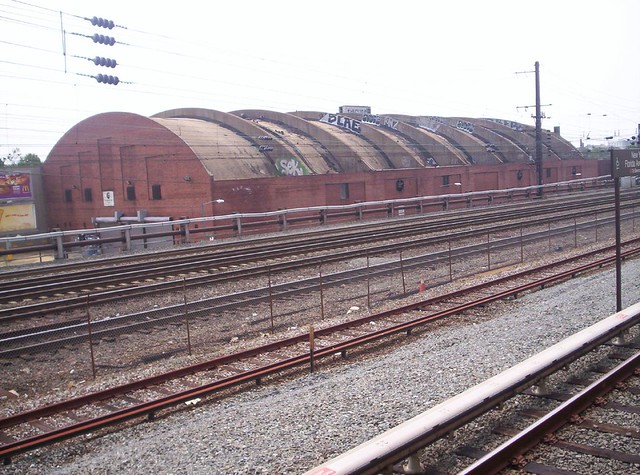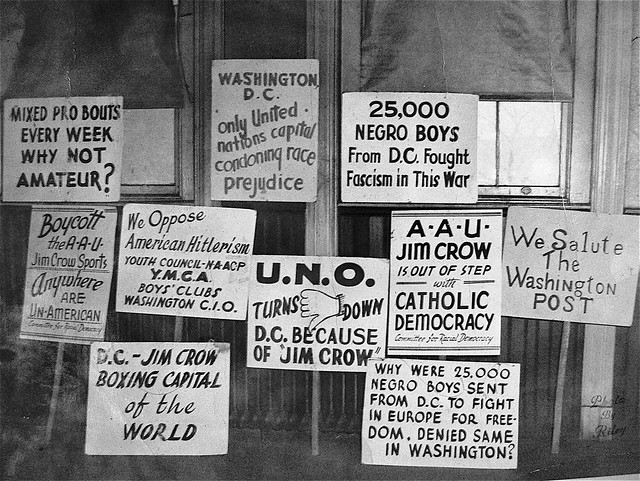Historic Preservation Tuesday: Adaptive Reuse and the Uline Arena
The Uline Arena is a vaguely industrial building located just east of the NoMA Metrorail station, between 2nd and 3rd and M Streets NE. The building has gone through a number of iterations--as a concert, events and sports arena, church, and a trash transfer station. In 2003, in face of a proposal by the then land owner to demolish the building, I led an eventually successful effort to get the building designated as a historic landmark.
 I thought the building was important to save because it represented a variety of themes in DC's history, with both local and national ramifications.
I thought the building was important to save because it represented a variety of themes in DC's history, with both local and national ramifications.The building was an event site that when I first looked into it, was only relevant to me because it was the site of the first public Beatles concert in the US.
But it had been home to professional sports teams, the Ringling Bros. circus, the Ice Capades and a wide range of concerts.
It was built by Migiel Uline, an impresario of ice making, who thought he could extend his prowess to professional hockey, which was the main tenant of the building when it first opened in the early 1940s.
 Right: protest signs from the Campaign to Integrate Uline Arena, 1948-1949. From the collection of Edwin B. Henderson II.
Right: protest signs from the Campaign to Integrate Uline Arena, 1948-1949. From the collection of Edwin B. Henderson II.The Uline is very interesting because of how it relates to the local and national civil rights history.
It was a segregated events facilitly--although Mr. Uline claimed that the policy was up to the sponsor of individual events. But after a steady year of protests at every event, in 1949 the building was integrated.
This was about 4 years before the courts ruled that DC public accommodations had to be integrated in the Thompson Restaurant case and 5 years before the ruling in Brown v. Board of Education.
Later Earl Lloyd, one of the first black players for what has become the NBA, played for the Washington Capitols basketball team. He died last week ("Earl Lloyd, first African American player in the NBA, dies at 86," Post). Elijah Muhammed and Malcolm X spoke at rallies there, the Poor People's Campaign rented the facility to use while they protested on the National Mall.
But it is also important for how it demonstrates industrial architecture and the reality that DC isn't just monumental civic architecture, and it is a significant example of advances in concrete technology and truss systems, which allowed for the construction of the interior without pillars allowing unobstructed views.
Sadly, while the company that owns 9:30 Club was after the owner for many years to allow them to lease or buy the building to bring it back as a concert facility, he was never interested.
The building is now slated to become an REI store ("National Outdoor Retailer REI to Open Flagship in Historic Uline Arena," press release), one of five extra special flagship stores.
Interestingly, I still remember how angry H Street Main Street co-founder Kevin Palmer was when he saw REI signs on Metrobuses announcing that with their new store in Tysons Corner Virginia, REI was now in "Washington."
Now they will be.
But I can't claim that was the outcome I was capable of envisioning back in 2003.
Labels: arts-culture; concerts-music;, cultural heritage/tourism, historic preservation, local history, urban history, urban revitalization




2 Comments:
"But I can't claim that was the outcome I was capable of envisioning back in 2003."
As you have repeatedly acknowledged, you're clearly not cut out to be a politician. ;^)
-EE
I am from Michigan where Kmart (formerly Kresge) is based. I wrote to them in the late 1980s suggesting that they open a store in the H Street area...
I laugh a lot at myself, thinking of some of my ideas for H St. pre-knowing a lot more about revitalization.
Post a Comment
<< Home